
copyright 2004 by George Johnson

The Sky at Fort Union, photo by George Johnson
Part 1. Rebecca's House and Ludwig's Castle
Part 2. The Chamber of Commerce's (Not So) Secret Candidate
Part 3. David Pfeffer's Letter and Mayor Delgado's Award
Part 4. Tom Mills and the Elusive Qualities of Life
Part 5. The Great Masquerade: Memories of the 2002 Campaign
Part 6. Why Nature Abhors a Vacuum: Political Coverage, Santa Fe Style
(Brief Interlude: What the Water Budget Really Means)
Part 7. Into the Heart (and the Soul) of Santa Fe
Interlude: Subliminal psychology . . . a scoop by Journal North February 20, 2004
Part 10. The Demagoguery of Matthew Ortiz
On a trip to Seattle last week, I passed the time rereading a favorite book from college days: Robert Penn Warren's All the King's Men. In the novel, one of the best written about American politics, Willie Stark, an ambitious, self-educated farm boy -- one of the hicks, he calls himself -- rises from the red southern clay and, law diploma in I was inspired to pick up the book again after witnessing a performance by one of our City Councilors at a recent session of the Finance Committee devoted to the ever-contentious and tedious issue of neighborhood speed controls, The committee members waited as, one by one, the speakers described the danger of speeding traffic on the narrow winding streets of old Santa Fe. Then the debate began, and Matthew Ortiz erupted into action.
And what a show it was. He chastised the Eastside residents for having "feelings of entitlement" to city funds, casting their testimony as an orchestrated performance by the privileged class. His voice dripping with contempt, he grilled city staff members on the most basic details of how traffic control money is spent. The answers could be found in the information packets on the councilors' desks -- the law, after all, has been on the books for three and a half years. But Mr. Ortiz preferred to wing it. Overtaken by the momentum of his own zeal, he began firing off one amendment after another, each apparently improvised on the spot and each designed to make sure District 4 got the biggest piece of the pie.
Under the existing rules, for example, a street is deemed eligible for traffic calming if the average velocity and volume of its traffic exceeds a certain threshold. (Bear with me. I know this sounds boring.) Because of safety concerns, speed has historically been given a slight preference. The ratio, Mr. Ortiz declared, must be turned on its head. Traversed by the clogged arterials feeding Cerrillos Road, District 4 would benefit from favoring volume over speed. Any other considerations were irrelevant.
He was equally exercised by a citizens advisory group's recommendation that extra weight be given to streets with houses built extremely close to the curb, an artifact of the days before there were such niceties as zoning laws. People sleeping with their heads a few feet from traffic, the task force had reasoned, may deserve some extra consideration.
The argument was lost on Mr. Ortiz. It is in the old parts of Santa Fe -- the downtown and Eastside neighborhoods of Districts 1 and 2, the old Westside neighborhoods of Districts 1 and 3 -- where houses without setbacks exist. Platted in the 1960s and '70s by Dale Bellamah and the other big developers, homes in District 4 were required to have more elbow room. A rule that would benefit residents of, say, Camino Cabra, might do so at the expense of Siringo Road. Or so it seemed to Matthew Ortiz, for whom all politics is a zero-sum game.
If I lived in District 4, I might be grateful to have a councilor watching out for my interests with such aquiline ferocity. But the manner in which the Councilor managed to pit the Southside against the Eastside, the middle class against the wealthy, the Hispanics against the Anglos, the natives against the newcomers -- the people who, in the words of the American statesman Deborah Jaramillo, "just got off the bus" -- made me feel that I was witnessing a demagogue in the making, a practitioner of the politics of divisiveness, the Southside's version of both Al Sharpton and Huey Long.
And of the fictional Willie Stark. In the symbiosis of demagoguery, pleasing the masses must be balanced with pleasing the business interests. You will need their money when you are ready to run for mayor or governor -- wherever you leap next in the irresistible grab for power.
No surprise then that while Mr. Ortiz is championing the living wage ordinance, he is lining up with Rebecca Wurzburger to bend the zoning laws in favor of the developers. Smaller lot sizes, reduced setbacks, denser zoning -- all can be portrayed as measures to create affordable housing by tipping the scales of supply and demand. The real result, of course, is that the most desirable and expensive parts of Santa Fe have become heavy construction zones, with luxury spec houses squeezed onto every remaining bit of empty land. The builders make the big money, and Mr. Ortiz's constituents get more construction jobs.
This grand unified theory of Matthew Ortiz also goes a long way toward explaining why, for all the enemies he has accumulated, he is essentially running unopposed in the March 2 election, with token opposition from Mark Bentley. One would think that a councilor who, just months ago, was accused of "a pattern of misconduct" by the New Mexico Supreme Court's Disciplinary Board (see "Councilor's Law License Might be Suspended," Santa Fe New Mexican, August 26, 2003, p. A1), would be easy prey. Amazingly this issue hasn't been raised once during the months of the campaign, not in the New Mexican or Journal North, or even, as far as I can tell, by Mr. Bentley. The story has disappeared from the papers.
Some of this reticence can be laid to Santa Fe's pathologically polite politics, in which any suggestion (except in private) that one's opponent is less than an upstanding citizen is decried as "negative campaigning." But more importantly, no one is targeting the District 4 races as they are the races in Districts 2 and 3.
Liberal Democrats and labor groups are happy with Mr. Ortiz's support of the living wage ordinance. (His contributors include two well-known labor lawyers, Morton Simon and Carol Oppenheimer.) And much as the Chamber despises the new law -- a considerable amount of its members' dues are going toward trying to overturn it in court -- the organization knows that when it comes to growth and development, Mr. Ortiz will vote their way.
Where all this comes to focus is in the power play over water, a matter to be considered in the next installment when we return to Sweeney Auditorium on a summer evening in 2002 and watch Willie (I mean Matthew) Ortiz, roll up his shirt sleeves and get to work.
Part 8. Mr. Miller's Smoking Gun
Part 9. The Journal Follows the Money (and a Visit from the Berardinelli Robot)
Part 10. The Demagoguery of Matthew Ortiz
Part 11. The Thornburg Companies and United Way
. . . and a call from the Chamber of Commerce

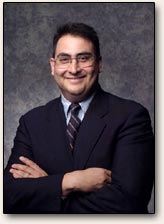 or "traffic calming." My interests were selfish. I was there with about a dozen members of the Canyon Neighborhood Association, which straddles Districts 1 and 2, to speak against any attempt to exclude historic neighborhoods from the program. (This in itself involves some interesting political subterfuge and will be the subject of a future installment.)
or "traffic calming." My interests were selfish. I was there with about a dozen members of the Canyon Neighborhood Association, which straddles Districts 1 and 2, to speak against any attempt to exclude historic neighborhoods from the program. (This in itself involves some interesting political subterfuge and will be the subject of a future installment.)

I hadn't meant to write again so soon, or to be diverted from the saga of Matthew Ortiz. Then two curious campaign artifacts arrived. The first was yet another
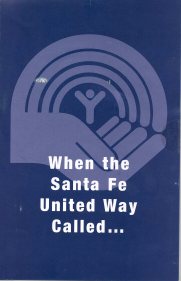
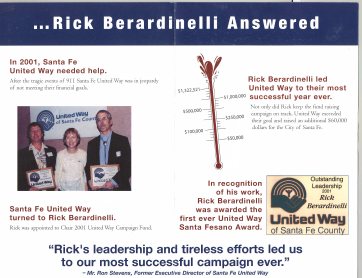 memories of the national United Way scandals of years past: "If Rick Berardinelli was able to keep United Way on the right track, just imagine what he can do on the City Council!"
memories of the national United Way scandals of years past: "If Rick Berardinelli was able to keep United Way on the right track, just imagine what he can do on the City Council!"
His efforts at raising money for charity are nothing but admirable, and he deserves all our thanks. But I can't help but wonder how many of the thousands of Santa Feans who receive this brochure will be left with the impression that United Way is somehow championing Mr. Berardinelli's candidacy, or has agreed to the use of its symbol as a stamp of approval for his campaign. I sent a query to Katherine Freeman, United Way Santa Fe's President and CEO, and received a quick reply from the number two man in charge:
From: Frank Di Luzio Subject: RE: United Way's endorsement of Rick Berardinelli Date: February 20, 2004 10:35:21 AM MST Mr. Johnson: Ms. Freeman is away for the day and asked that I respond on her behalf. The United Way of Santa Fe County has not endorsed Mr. Berardinelli nor any other candidate. The use of the logo was not authorized by us. If you wish to discuss the issue further, please feel free to call. Thank you, Frank Di Luzio Vice President Community Impact United Way of Santa Fe County
(Many will recognize Mr. Di Luzio as a well-liked and respected former Fire Chief and City Manager.)

Artifact 2, a memo sent by the Thornburg Companies to its employees, came to me by way of two different readers:
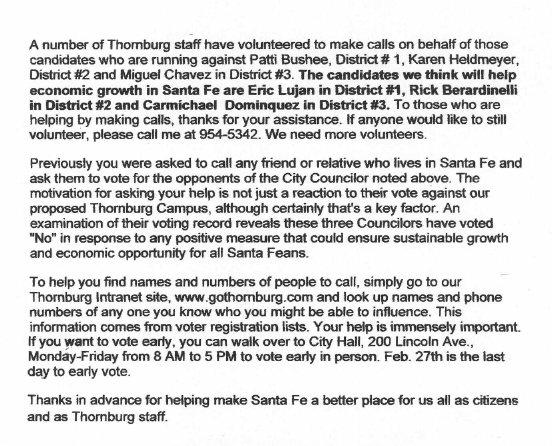
Thornburg, of course, is the local investment firm that is fighting for city approval to build a 100,000-square-foot office complex -- or "campus," as these things are now called -- in Northwest Santa Fe. The company is apparently as adept at playing politics as at playing the financial markets. Employees are being mobilized not just to vote but to log in to a password-protected website and scan voter lists for people whose arms they can twist.

February 21, 2004
Interlude: Subliminal psychology
In a letter to the editor in this morning's New Mexican, Rick Berardinelli
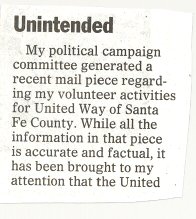
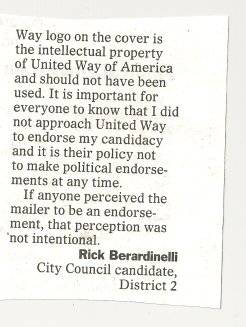 putting a reporter on such a good story.
putting a reporter on such a good story.
While awaiting the city council endorsements in tomorrow's dailies, I have some old business to dispense with: I see from the Berardinelli brochures that his treasurer is one Phil Garcia, a name I was puzzling over a few installments ago after he was listed as a $1,000 contributor, a high roller in Santa Fe city politics. A bit of digging persuades me that this, more likely than not, is Phil Garcia of Garcia, Kraemer & Associates, an Albuquerque real estate consulting company whose clients include developer Gerald Peters.
And remember J. D. Wesselkamper, the other $1,000 donor I was wondering about? Yesterday's events lead me to conclude that this has to be Joe Wesselkamper, who is listed on the Board of Directors of United Way Santa Fe. That is all anyone seems to know about him. His name has the distinction of having never appeared in either local newspaper, at least since they have been archived electronically. Mr. Wesselkamper, readers may recall, is listed in the phonebook as residing in Eldorado. One can venture that Mr. Garcia probably doesn't live here either. I'm still hoping one of the dailies will take on a detailed analysis, "Where the Money Comes From," authoritatively determining how much of the Chamber candidates' support was dispatched from beyond the city limits. There are still nine days to go until the election . . .
On to new business. I couldn't resist juxtaposing the slickest of the three Berardinelli flyers . . .
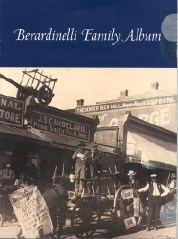
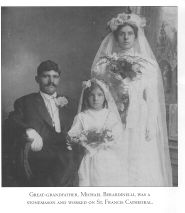
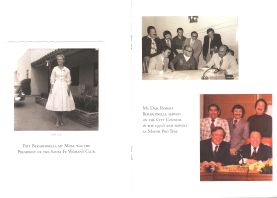
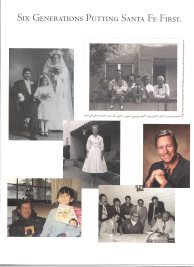
. . . with the hopelessly nerdy one from the Heldmeyer campaign.
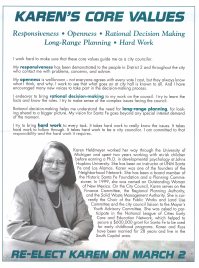
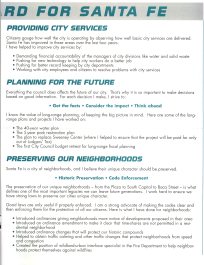

Doesn't hers remind you of those musty old advertisements in ancient copies of Life or The Saturday Evening Post, when whole blocks of print -- sentences and paragraphs! -- were used to make a point? It is so 1960s. Ms. Heldmeyer's campaign literature harks back to a time when advertisers, including candidates, reached for the mind through the neocortex, instead of bypassing it altogether, flashing images directly to the reptilian brain.

I can't believe that I almost missed this:
Score another one for Journal North. You can click on the above image to read the rest of the story. Note particularly the two circled paragraphs toward the end.
February 22, 2004
Postscript: A Call from the Chamber of Commerce
So many rumors are, in the end, too good to be true, and I assumed that would be the case when I heard that campaign calls for Mr. Berardinelli are being dialed from the headquarters of the Santa Fe Chamber of Commerce. Lacking independent confirmation, I let the matter drop. Then, yesterday evening the telephone rang. The caller was a young woman reading, with considerable difficulty, from a script urging a vote for Rick Berardinelli. From her halting delivery, it seemed doubtful that she was a volunteer (it might as well have been the Berardinelli robot), and a glance at the caller ID display revealed the source of the call:

I hadn't believed that the Chamber could be quite so stupid. Or maybe its leaders have finally decided to dispense with their charade. Either way, an organization that could be doing so much good for this town is instead turning itself into a laughing stock. It almost defies belief that board members like Joe Hoback, whom I've written about here before, and Alan Austin, a respected banker and community leader, would countenance such clownish behavior. And The New Mexican should consider it an embarrassment that its own publisher sits on the Chamber board.
Not that I believe for a moment that this influences the paper's editorial decisions. Witness this morning's endorsements of all the incumbents, except Matthew Ortiz. But appearances matter. It is a conflict of interest for a newspaper to hold a prominent position in an organization that campaigns for candidates and promotes a political agenda. (Journal North, by the way, also endorsed Councilors Heldmeyer, Chavez, and Bushee, and declined to recommend anyone in District 4. The New Mexican, apparently feeling that it had to pick somebody, went with Mark Bentley.)
This morning's Journal also carried a letter from Fred Rowe (the attorney who dubbed the sham water budget the "toilet tax") that cuts to the heart of this whole sad affair:
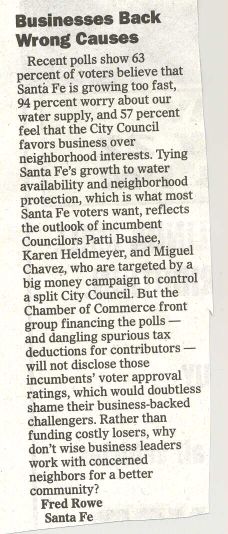
. . . on to Part 12, The Archeological Impact of Rick Berardinelli
Coming Soon: Demagoguery II, The Summer of 2002
The Santa Fe Review. Please bookmark this site and check back regularly for further installments.
Comments (for possible publication) may be sent to

More links:

Santa Fe water information, a collection of seminal documents and links